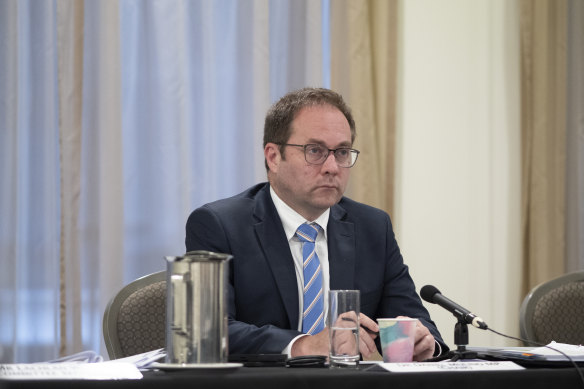
Throughout that year, 27 people were killed and more than 300,000 insurance claims were made by households affected by the floods in Queensland and NSW in February and March; the Hunter and Greater Sydney in July; Victoria, NSW and Tasmania in October; and Central West NSW in November and December.
A lack of consistent and reliable flood risk data is making it harder for communities to prepare for floods, and is complicating preparedness and response efforts, the committee found.

Committee chair Daniel Mulino said while he recognised the need to unlock new developments to address the housing supply crisis, that needed to be balanced against mitigating serious risk. Credit: Elke Meitzel
It has recommended national cabinet work together to prevent further developments in areas that face a 1-in-100 year flood risk or greater, and urged the federal government to explore ideas to expedite that process. That could include regulation to discourage banks lending in highly flood-prone areas by risk-rating banks’ capital to reflect flood risk, and agreement between government, the Australian Prudential Regulation Authority and banks that such loans will not occur.
“These measures could apply to lending to both developers and to residential purchasers. Access to any flood pool (or subsidies) would not be available to properties approved in high-risk areas after the creation of the scheme,” the report says.
Loading
Mulino told this masthead that while he recognised the need to unlock new developments to address the housing supply crisis, that needed to be balanced against mitigating serious risk.
He said buying a house in a flood plain would not be in the best interests of first home buyers, who would not be able to insure their homes.
“There are so many people who don’t have insurance or can’t get insurance,” he said. “We just can’t continue with the status quo.”
The committee extensively examined delayed claims-handling by insurers, finding one of the most significant points of contention between policyholders and the insurance company, which hindered timely settlement, was the condition of stumps.
Insurers can often deny claims after a flood if it determines the stumps under the house were not maintained to a reasonable condition before the natural disaster hit. The committee said home owners were often unaware their stumps had defects when taking out a policy, or that their condition would be assessed when they made a claim.
To simplify the process, it has recommended making changes to the insurance code of practice distinguishing between requiring maintenance for observable parts of the home (such as roofs and gutters) and not observable (stumps).
“Where maintenance is not observable and infrequent maintenance is required, there should be a presumption of coverage by insurers unless exceptional circumstances can be established,” the committee recommended.
Coalition MPs Garth Hamilton, Keith Wolahan and Kevin Hogan issued a dissenting report, making a further three recommendations and suggesting amendments to some of the recommendations in the main report. The trio wants insurers to be allowed to continue offering policyholders in high-risk flood areas the option to decline flood coverage, and called on governments to spend more on mitigation.
Independent MP Andrew Gee, whose seat of Calare in regional NSW was severely hit by the 2022 floods, also issued a “supplementary opinion” to make a further 38 recommendations. He said it was clear the rebuilding and recovery process in his community was made harder by the “cold-hearted and shocking response of insurers to policyholders”.
Loading
The Insurance Council of Australia said it “strongly supported” recommendations that put downward pressure on premiums, such as abolishing state-based taxes, but would take time over the coming months to digest the rest of the recommendations.
“Insurers acknowledge there were failures of systems, processes and resourcing in response to the extreme weather events that occurred during 2022, and the industry is already taking action to address these challenge,” the council’s chief executive, Andrew Hall, said.
“Getting the balance right between good customer outcomes without putting further pressure on premiums will be key to successful implementation.”
Financial Counselling Australia, which worked with residents battling their insurers over the 2022 floods, welcomed the report, adding there was a “widespread practice of offering inadequate cash settlement amounts”.
“Now is the time for action. The system has to change, and it’s up to the industry, regulators and government to ensure these recommendations are enacted as soon as possible,” said Vicki Staff, Financial Counselling Australia’s disaster recovery coordinator.
The Business Briefing newsletter delivers major stories, exclusive coverage and expert opinion. Sign up to get it every weekday morning.









 Add Category
Add Category